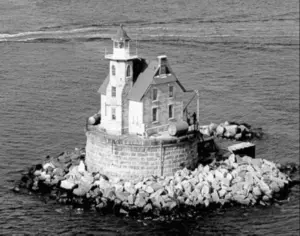It seems that ghosts like to hang out in lighthouses. There are myriad stories of hauntings and scary happenings in many of the lighthouses along our coasts. Damp, isolated, and lonely they’re also the scene of many shipwrecks and tragedies. The violent deaths from these disasters could leave behind a spiritual residue or life force that lingers where it happened. There’s a place within sight of the Watch Hill docks that is considered one of the most haunted places in the country. Do you believe in ghosts? Maybe not, but the many strange happenings at Race Rock Lighthouse would have most people quivering like a bowl of Jelly.

Race Rock Lighthouse stands in Long Island Sound at the mouth of the Long Island Sound where the waters of the sound rush both ways with great velocity and force. It is a lonely spot and the scene of many shipwrecks. By 1837 eight vessels had been lost in eight years on Race Rock Reef.
In 1852 the Lighthouse Board reported: “Various efforts have been made, and numerous appropriations expended, in endeavoring to place an efficient and permanent mark on this point. Buoys cannot be kept on it, and spindles have hitherto only remained until the breaking up of the ice in the spring.”

In all, 10,000 tons of granite was used in the foundation. The Board reported in 1872 that the building costs were so high that more money was needed. Congress appropriated a further $75,000 in 1873 and the lighthouse was completed at a total cost of $278,716, an immense sum of money at the time.
Captain Scott was a larger than life character whose salvage company worked on many shipwrecks. In 1869 he was tops in his field and was assigned the task of removing the wrecked iron steamer Scotland in New York. Iron chested and phenomenally strong, Captain Scott succeeded where others had failed. Among other things he built the seawall at Governor’s Island and the foundation for the Statue of Liberty. Captain Scott’s most famous exploit happened in 1870 when the Hoboken Ferry was rammed by a tug in the ice-filled New York harbor.
Hearing the ferry’s alarm Captain Scott jumped aboard and helped to cram mattresses into the large hole in the ferry’s side. He forced his own body into the hole to keep the packing in place using his arm outside to hold him there for an hour while all the passengers were saved. This was just the man Smith needed to build his lighthouse.
After seven long years, the light was finally finished in 1879. Now successful Captain Scott settled down with his family in New London. He bought a house on Thames Street and ran his business from a 200-foot long pier on Pequot Avenue. At one time his company employed 150 men.

Over the years crews that were stationed at the lighthouse claimed they started to hear voices, whispers, yelling, and laughter echoing thru the rooms. Some even said they felt like they’d been touched or pushed, others said that they heard footsteps and saw wet footprints leading out of the shower area.
In 1978 the Coast Guard automated the light and there have been no crews stationed there for over forty years. Yet there have been recent reports by boaters of the shadowy figure of a man standing in the tower. He is visible when the light passes over him. Is it Tom Carroll or one of the victims of the numerous shipwrecks?

Race Rock Lighthouse is now owned by the New London Maritime Society and was added to the National Register of Historic Places in 2005. New London’s Custom House Maritime Museum sometimes gives tours of the lighthouse in the summer but only in good weather and at slack tide. If you go say hello to the ghosts for me.







